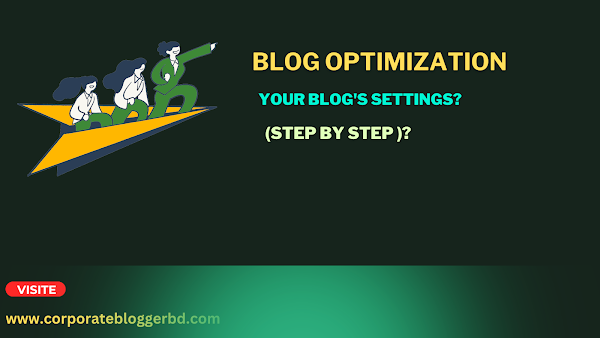 |
| Blog Optimization |
Managing your blog's settings effectively ensures better performance, SEO, security, and user experience. Below is a detailed breakdown of key settings you should configure and manage.
1.General Blog Settings:
Blog Title & Tagline
Purpose: Defines your blog’s identity in search engines and social media.
Where to Set:
WordPress: Settings > General
Blogger: Settings > Basic
Custom CMS: Admin panel under Site Configuration
2.Site URL & Permalinks:
Purpose: Affects SEO and link structure.
Best Practices:
Use a clean, readable
structure (e.g., /blog/post-title/).
Avoid dynamic parameters (?id=123).
Where to Set:
WordPress: Settings > Permalinks
Blogger: Settings > Permalinks (limited customization)
3.Timezone & Date Format:
Purpose: Ensures correct post scheduling and display.
Recommended Format:
Date: YYYY-MM-DD (SEO-friendly)
Time: 24-hour format for consistency.
4.Writing & Content Settings
Default Post Category & Tags
Purpose: Helps organize content automatically.
Best Practices:
Set a default category (e.g., "General").
Avoid excessive tags (5–10 per post max).
5.Excerpt Settings:
Purpose: Controls how post summaries appear in feeds/search results.
Options:
Manual Excerpts (Recommended for SEO).
Automatically Generated (First 55 words).
6.Comment Settings:
Purpose: Manages user engagement and spam.
Key Settings:
Enable/Disable Comments (Globally or per post).
Comment Moderation (Hold for review if containing links).
Anti-Spam Plugins (Akismet, CleanTalk).
7.Reading & Display Settings
Homepage Display
Options:
Latest Posts (Dynamic, good for blogs).
Static Page (Good for business sites).
8.Blog Pages Show at Most:
Purpose: Controls how many posts appear per page.
Recommended: 6–10 posts for optimal loading speed.
9. RSS Feed Settings:
Purpose: Controls how your content appears in feed readers.
Best Practices:
Show Full Text (Better for engagement).
Limit feed to summary if concerned about scrapers.
10.Discussion & Community Settings
Pingbacks & Trackbacks
Purpose: Notifies other blogs when you link to them (can attract spam).
Recommendation: Disable unless necessary.
11.User Registration & Roles:
Purpose: Controls who can contribute.
Options:
Open Registration (Risky, may attract spam).
Invite-Only (Best for team blogs).
12.Media & File Upload Settings
Image Optimization
Purpose: Improves page load speed.
Best Practices:
Set maximum image dimensions (e.g., 1200px width).
Enable lazy loading.
13.File Upload Restrictions:
Purpose: Prevents abuse (e.g., large uploads).
Recommended Limits:
Images: 1MB max.
PDFs/Docs: 5MB max.
14.Privacy & Security Settings:
Visibility to Search Engines
Purpose: Controls indexing.
Best Practices:
Allow indexing for public blogs.
Block indexing for private/staging sites.
15.HTTPS & SSL Enforcement:
Purpose: Secures data transmission.
How to Enable:
Install an SSL certificate (Let’s Encrypt, Cloudflare).
Force HTTPS in settings.
16.Backup & Recovery:
Purpose: Prevents data loss.Recommended Plugins:
UpdraftPlus (WordPress).
Automated cloud backups (AWS, Google Drive).
17.Performance & Caching Settings
Caching Plugins
Purpose: Speeds up page loading.
Best Options:
WP Rocket (Premium).
W3 Total Cache (Free).
18. CDN Integration:
Purpose: Reduces server load and improves global speed.
Best Services:
Cloudflare.
BunnyCDN.
19.SEO & Analytics Settings:
Search Engine Visibility
Purpose: Controls whether search engines can crawl your site.
Where to Set:
WordPress: Settings > Reading ("Discourage search engines").
20.Google Analytics & Search Console:
Purpose: Tracks traffic and search performance.
How to Add:
Insert tracking code in <head> or use a plugin (e.g.,
MonsterInsights).
21.XML Sitemap
Purpose: Helps search engines index content.
Best Plugins:
Yoast SEO.
Rank Math.
Final Checklist for Blog Management:
✅ General
Settings (Title, URL, Timezone)
✅ Content Settings
(Categories, Excerpts, Comments)
✅ Reading Settings
(Homepage, Posts per Page)
✅ Media Optimization (Image
sizes, Lazy load)
✅ Security (HTTPS, Backups,
Spam Protection)
✅ Performance (Caching,
CDN)
✅ SEO (Analytics, Sitemap,
Meta Tags)
By following these structured settings, you can optimize your blog for better performance, security, and search rankings.
Would you like a deeper dive into any specific section?
